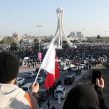Special Commentary: Iran and the Bahraini Uprising
By:

The social upheavals occurring in the Middle East, triggered by the suicide of a fruit vender in Tunisia earlier this year, have been largely precipitated by a number of factors ranging from economic mismanagement, inflation, unemployment, corruption and lack of political rights and freedom. But what differentiates the uprising in the Persian Gulf’s tiny island of Bahrain, according to some analysts, is the sectarian conflict between the ruling Sunni and the larger Shi’a population, which has been discriminated against on both economic and political institutional levels. What lies simmering in the background, some argue, is the tension between Shia Iran and Sunni Saudi Arabia, who compete for regional dominance, while the American Fifth Fleet based on the island continues to play a crucial role in safeguarding the flow of oil in the Persian Gulf and containing Iran’s regional ambitions.
In reality, however, the role of sectarianism, and particularly Iran’s influence in the uprising, is limited in several ways. It is true that Bahrain’s Shia population has suffered under widespread institutional discrimination by the pro-monarchy Sunni rulers, who perceive them as Iranian loyalists. Bahrain’s sectarian problem, however, mainly on the rise since the late 1970s, is largely economic and institutional, rather than nationalistic. While Manama aims to describe the recent events as an Iranian-instigated rebellion, the main cause of the Shia-led uprising is the government’s unwillingness to expand the 2000 reform initiative of informal and formal practices of discrimination, electoral restrictions in the free formation of political parties and failure to address the weakening of socio-economic issues, especially the high unemployment rate.
The nationalistic factor does play a critical role as well. Most Bahraini Shias are proud Arab nationalists who want to maintain their country’s independence from Iran. It is true that the Shias in Bahrain have relatively close economic and religious ties with Iran, but the two communities still comprise very diverse economic and religious groups. More importantly, Shia opposition movements are not transnational, some of which maintain discontent on the local level with political factions like al-Wifaq, the largest political party, and Islamic Action Society (ISA), which is seeking to gain greater influence in municipal politics rather than carrying out Tehran’s foreign policy ambitions. In terms of religious identity, these Shia factions follow a diverse number of Shia religious authorities (marja`iyya) from Lebanon and Iraq, since there is no resident high-ranking cleric on the island. The most revered Grand Ayatollahs in Bahrain are Ayatollah Sistani in Najaf, Ayatollah Muhammad Sadeq Shirazi in Qom and Ayatollah Muhammad Taqi al-Mudarrasi in Karbala. Ayatollahs Sistani and Shirazi, for instance, are not in line with Iran’s theocratic ideology, and their conception of clerical involvement in politics is more in support of electoral politics rather than militant activism and the formation of an Iranian-style theocracy.
The “glove-puppet Western-oriented Sheikhdom” of Bahrain has been historically a soft spot for the Islamic Republic (Press TV, February 27). Since the 1979 Revolution, a number of Iranian officials have explicitly called Bahrain an Iranian province. In many ways, Tehran sees Bahrain as another battle ground for expanding its regional influence, despite agitating the Sunni rulers of the island and their greater allies, the Saudis. In broad terms, from Tehran’s perspective the Bahraini uprisings mark a historical moment in the decline of American hegemony in the region and the broader globe (Press TV, February 23; Fars, February 24). Like in Egypt and Tunisia, Bahrain’s ruling oligarchs, funded and supported by Washington, are losing popular support and the loss of another American puppet regime in the region, especially one geographically close to the Islamic Republic, could be a huge blunder for U.S. interests (Press TV, February 24). While Tehran is calling for calm and non-violent resistance against the ruling family (Mehr, February 18), the Islamic Republic continues to defend the Bahraini Shias against a perceived American threat, even sending a stern warning opposing possible U.S. military action against the protestors (February 22, IRNA; Press TV, February 22). In another important report, Bahraini opposition leader of the Haq Movement, Hassan Mushaima, perceived by some as an Iranian sympathizer, has also hinted at possible Iranian intervention in case Saudi forces begin to directly aid the Bahraini army against the protesters (Al-Alam, February 18).
The Iranian narrative of the Bahraini uprising in terms of anti-imperialism and sectarian conflict is merely a reflection of Tehran’s attempts to exert power in a region undergoing dramatic changes. The fact is that the Bahraini upheaval, similar to other movements in the region, is about the fair distribution of power, accountability, transparency and effective governance. Class warfare, in many ways, is at the heart of the conflict. For the most part, however, Riyadh and Tehran will continue to describe the latest uprising in sectarian terms. Yet the further this narrative is pushed to the fore, the longer the current conflict in Bahrain will persist. As one Shia opposition leader, Sheikh Ali Salman, has warned, the political instability in the country could, like Libya, tear the country apart with graver consequences to regional stability in the Persian Gulf; unless the government introduces radical reforms as soon as possible (Press TV, February 23).
Babak Rahimi received a Ph.D. from the European University Institute, Florence, Italy. Dr. Rahimi has also studied at the University of Nottingham and London School of Economics and Political Science, UK. He was a Senior Fellow at the United States Institute of Peace from 2005-2006, where he conducted research on Ayatollah Ali al-Sistani and Shiite politics in post-Baathist Iraq. He is currently an Assistant Professor at the Department of Literature, Program for the Study of Religion, University of California, San Diego.




